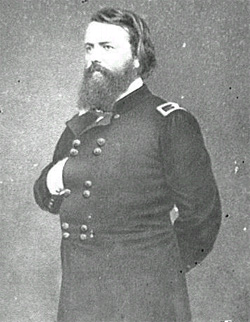
John Pope
John Pope was born in Louisville, Kentucky, on March 16, 1822. An outstanding student in his West Point class of 1842, he posted to the Topographical Engineers. He served under General Zachary Taylor during the Mexican War, earning two brevets; yet he was still a Captain after 14 years of military service.
Luck came his way when he was assigned to command Lincoln’s escort before his inauguration in 1861, and was soon after promoted to Brig. General of Volunteers.
Despite a slow start, his organizational skills served him well in a string of commands in Illinois and Missouri, as the Union tried to make soldiers of untrained volunteers.
In February of 1862, he was assigned to command the Union Army of the Mississippi which, though not large, was stronger than any nearby Confederate force.
He scored major successes at New Madrid and by capturing Island No. 10 in the Mississippi River, allowing the Union access to the river itself.
Given command of a larger force in northern Virginia, charged with taking the Confederate capital of Richmond, Pope’s first act was to issue to his Eastern troops a bombastic proclamation that he can come from the West, where the Union armies were in the habit of seeing the backs of their enemies.
Shortly after assuming command, Pope crossed the Rappahannock River, reaching Culpeper on the Orange & Alexandria Railroad, threatening the vital Virginia Central Railroad connecting Richmond with the Shenandoah Valley.
General Robert E. Lee ordered Jackson to move northward to provide a defense of Gordonsville, the junction with the Orange & Alexandria, only 27 miles from Culpeper.
Jackson’s force of 24,000 Confederate troops was on the march when it was attacked by a vanguard of Pope’s army, under the command of General Banks, at Cedar Mountain, just south of Culpeper. Banks drove the Confederates back until A. P. Hill’s “Light Division” moved up to defeat the heavily outnumbered Union troops. Jackson then withdrew to Gordonsville.
Learning that McClellan was abandoning his base at Harrison’s Landing and heading for the Potomac River, Lee moved quickly to destroy Pope’s army before McClellan’s troops could reinforce it. As Lee advanced, Pope retreated behind the Rappahannock.
Lee then divided his army in the face of Pope’s superior forces, and sent Jackson and Jeb Stuart’s cavalry on a wide flanking maneuver to the left. Jackson’s force, marching 54 miles in two days, burned the Union army’s supply depot at Manassas Junction and disrupted its communications.
Lee then retreated to an excellent defensive position at Groveton a few miles northwest of Manassas. Here it was that Pope caught up with them, wasting his strength in fierce but uncoordinated attacks on the Confederate lines.
On August 30, 1862, Lee, following behind Jackson with the remainder of his army, led by Longstreet, passed through Thoroughfare Gap, reaching the old battlefield of Bull Run. Longstreet stationed his troops on the right flank of Jackson.
Although the first of McClellan’s troops had joined Pope, the greater portion of the Army of the Potomac arrived too late to participate in the impending battle.
Pope attacked Jackson’s troops but was forced to retreat. Longstreet launched a counterstroke against Pope’s left flank, overwhelming the Union army.
Pope blamed his defeat on a lack of cooperation and the disobedience of certain officers of McClellan, particularly Porter, who was subsequently tried by court martial and cashiered.
The Union army lost 15,000 men at the 2nd Battle of Bull Run, and Pope was blamed. Relieved of his command, he was sent to Minnesota to deal with a Sioux uprising.
In September of 1862, however, he was appointed commander of the Department of the Northwest. Four years later he was promoted to full Major General.
He retired in 1886, and died in Sandusky, Ohio, on September 23, 1892.